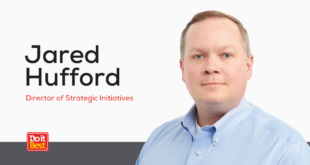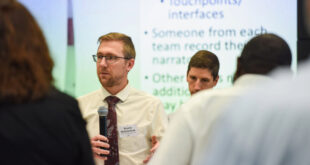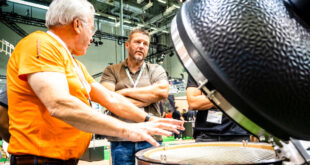Since cutting his teeth at an independent hardware store all through high school, Al Comeaux has lived, led and researched change from inside numerous organizations, including senior leadership positions at Travelocity, GE, Sabre and American Airlines.
 Today, he helps leaders steer their organizations successfully through change, and his 2020 book, “Change (the) Management: Why We as Leaders Must Change for the Change to Last,” is already considered one of the best change management books of all time.
Today, he helps leaders steer their organizations successfully through change, and his 2020 book, “Change (the) Management: Why We as Leaders Must Change for the Change to Last,” is already considered one of the best change management books of all time.
Before he serves as keynote speaker at the Independent Home Improvement Conference, Comeaux shares with Hardware Retailing insights from his extensive experiences and why change leadership is important. To learn more about the conference, visit ihiconference.org.
Hardware Retailing (HR): Tell us a little bit about yourself and your professional background.
Al Comeaux (AC): I spent four years in high school at an independent building specialty company. It was a mom and pop company owned by the parents of one of my friends. I worked the warehouse and the front desk answering the phones and helping customers.
I went on to get a degree in journalism, and then was in corporate communications for 30-plus years, helping people in large and small companies explain their story and what they were about. I learned along the way that change and getting people to change was not an easy thing. Data tells us that two-thirds of change efforts fail.
HR: How did you become interested in change management and change leadership?
AC: During my time in corporate communications, I was involved in some change efforts, and I started wondering why I was failing. And I am perfectly happy to admit that I failed because it was a great learning experience to go through. It was awful to go through, but it was also great learning.
I came to understand there’s something different about change versus all the other things we do. What I came to realize is that the actions we take every day and the aspects that make us great leaders actually make us not-so-great leaders of change. Leaders are good at solving problems, but those problems don’t always involve people. It takes a different set of skills and a different mindset to lead through solving problems while involving other people. We often get so used to solving problems by ourselves that we have to change our mindsets and remind ourselves that change involving people is a problem I shouldn’t solve by myself.
HR: Why is it important to include others in change and problem-solving?
AC: Change and problem-solving see benefits when there is more than one idea present. When you involve your people and the change is not just your idea, but their idea too, it makes the change more likely to happen. When you involve others, it might not go exactly how we want, but it’s more likely to happen and we are more likely to see the fruits of the change.
Another reason involving others is so crucial is because we don’t do our employees’ jobs every day. Whether you have 100 people or one working for you, we might understand their roles, but we don’t know all of the reasons why and how things get done. So when we come up with a new way to do things without talking to people about it and having them give us their ideas—when we try to solve that problem by ourselves—our ideas are naive.
If you’re going to change something that affects people—their work, how they do things, how they think—those are times you need to bring those people in and focus on change leadership. If change involves people and a new way for people to do things, we have to think of our people before the process.
HR: One of your tenants is that organizations don’t change, people do. Can you dive deeper into what you mean by that saying and how organizations can embrace this mindset?
AC: We have to have two different mindsets as leaders. We have an everyday mindset for the things that we’re working on and then we have to have a mindset for change. We can change a lot of different things that really don’t involve people. But when it involves people, if our people don’t change, there is no change.
People think they can have a great process for changing things. They can decide to change things and then tell everybody after they’ve made the decision. But that’s not going to get our people to want to change. We have to get people to want to change for there to be change.
In the social sciences, there is a concept called cognitive dissonance, which is the psychological discomfort we get in our minds and bodies when a value or belief we hold dear is somehow countered or challenged. The way we’ve always done it is tried and true, so when we tell our people that the way we’ve always done it is not the way we’re going to do it anymore, we’re upsetting this value that they have.
HR: What are some of the biggest obstacles to change for an organization?
AC: I spoke at an event for Home Hardware and beforehand, I spent time talking to dealer-owners across Canada, asking about their views on change. One owner-dealer told me what scares him the most is the attitude, “This is the way we’ve always done it.” And I heard those sentiments a lot from other retailers.
Another challenge is we want to move too fast. Action is important in our everyday leadership, and even during change, but when I looked at companies, I saw patterns emerging that the organizations that moved too quickly, change failed.
At the companies that took longer to execute, it wasn’t that they weren’t action-oriented, but their actions were figuring out what would work to solve this problem that’s going to lead to the change they needed. And then they figured out what to do based on all the employee feedback and their ideas were less naive.
I say that the patron saint of change is not the early bird, it’s actually the lowly duck. Before the ducks can take flight, they have to learn how to paddle in the same direction. We can’t have people going in every different direction and try to lead them through a change. It’s alignment before action.
HR: How do leaders overcome the resistance to change?
AC: We can be the boss and tell our people they just have to change. Or we can convince people that it’s the right thing to do, not just with the why, but by asking them the how. People want to know the “why” of change. They do need to understand why we’re trying to do this. But we also need to explain the “how.”
In my presentation, I talk about this company—Pixar—which wasn’t very big at the time and wanted to grow, but they needed to cut costs by 10%. Leadership at Pixar went to their employees and asked them for ideas for cutting costs. Their people got excited they actually got asked because this is not something that normally happens during a change.
Pixar’s employees put together ideas and the company held listening sessions to go over the best ideas. Some ideas were so popular they had to have two listening sessions for that idea. But there was this one idea that had to have seven separate sessions for it; everybody in the organization wanted to be a part of it. And that idea wouldn’t cut costs 10%, instead, it would cut costs 40%.
When people feel heard, they’ll do remarkable things. Our belief in our own deep knowledge of how our business works can get in the way and it can disadvantage us from ever learning about how those things can work and how much better our business can be.
HR: The theme of the Independent Home Improvement Center is Retail Operations and Innovation (ROI). How does change leadership fit into this concept?
AC: I’ve seen so many great innovations never happen because the people leading those efforts didn’t go and ask people for input to modify their great ideas that they’re so excited about. We get so excited about our innovation but we can get stuck in wanting it exactly the way we want it. We have to open up to the fact that it might not work because we don’t know everything, and we have to be willing to bring people along to make that change possible.
 Hardware Retailing The Industry's Source for Insights and Information
Hardware Retailing The Industry's Source for Insights and Information








